Driving up to Newcastle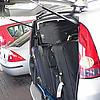

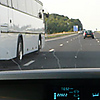
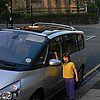
We've moved in! These photos are ordered geographically, starting at our Metro stop,
Kingston Park. Walking north up Brunton Lane, we pass a 'dene'--a big
green area running parallel to the Metro tracks where people with dogs
and soccer balls spend time.
After about four blocks, you walk into Gloucester Court, around the
shrubs, and there, along a quiet walkway, is Kathy holding Elena in
front of our rented house. It's a 'semi-detached' house: Our building
has two units joined at one internal wall.
The last photo is of our backyard.
We're about 100 meters from the edge of Newcastle. There is no
gradual transition, but rather high-density housing on one side of a
road, and farmland on the other.
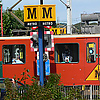
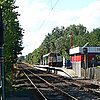
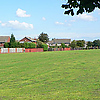
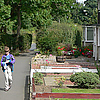
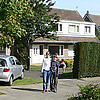
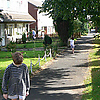
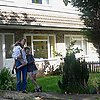
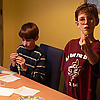
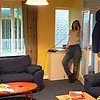
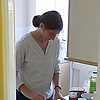
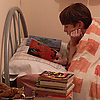
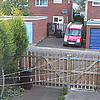
Wed, 7 Sep 2005
Newcastle snapshots
The fifth picture shows the repeating "terraced" houses which are typical of most of the housing closest to the city center.
In the panoramic shot you can make out a modern stadium to the left of the Cathedral. That's St James--home of the Newcastle United football (soccer) team who are hugely popular here. They started the season with not a single win or goal in their first four games. But the big local news is that they just signed English National Team star Michael Owen for 16 million pounds, and expectations for the rest of the season have skyrocketed.
Peter was relieved when Kathy found the public library. The staff are
good pushers of books, and we all walked out with library 'tickets' on
our first attempt.


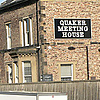
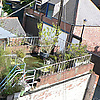
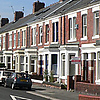
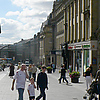
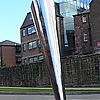

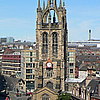
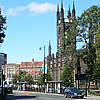
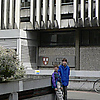
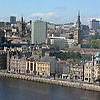
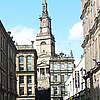
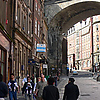
Bridges of Newcastle
The reason for the name of the "Swing Bridge" is probably obvious.
The Millenium bridge (starting with the fourth photo) is a pedestrian bridge that tilts up
in an interesting way to let ships pass underneath. There are actually *three* big hydraulic pistons on each side that are tilting the bridge.
Elena wanted to go *straight* onto the ferris wheel. Benj and I went along but were both a good deal more leery of the idea of being suspended in mid-air.
The big shiny building (last two photos) is SAGE Gateshead, a recently completed concert hall.
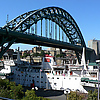
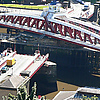
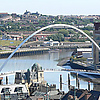
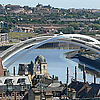
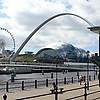
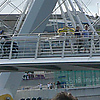
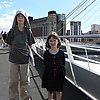

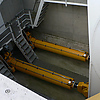
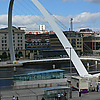
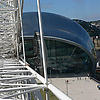
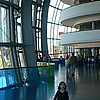

First day of school in Kingston Park We feel fortunate that they got in: Though there is preference given if you are close to a school, people from anywhere in the city can apply to any school, and Kingston Park was considered full when we arrived.
Inside the school it is mostly open. Classes are separated from each other by 6 foot partitions.
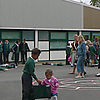

Thu, 8 Sep 2005
Alnwick castle and gardens
Along with a jester/magician and demonstration of birds of prey, the kids enjoyed the "Knights School"--an opportunity to dress up and get out the foam swords. Elena, the delicate damsel, is shown on a jousting practice rig.
The complex also includes ornamental gardens with Versailles-inspired water play. Our offspring were more fascinated by the "Poison Garden" (nightshade, etc) than the roses.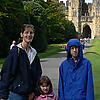
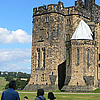
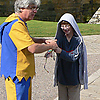
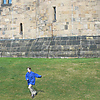
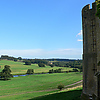
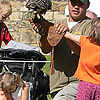


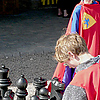
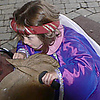
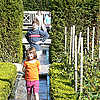

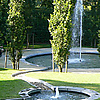
Mon, 12 Sep 2005
Beamish
The country house with the gardens is that of a well-off farmer from about 1820.
All were well staffed by folks in period costume who talked freely with visitors. The dentist noted that the mortality rate of those submitting to nitrous oxide at the time was about 3 percent.
For Elena in particular, the real attraction was the period transportation--a double-decker bus, a tram, and a double-decker tram, which were used to get from one site to another.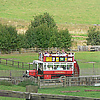
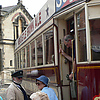
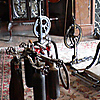

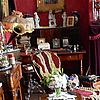
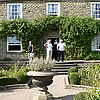

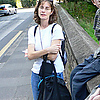
How clean is *your* wheelie bin?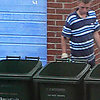

Seriously old churches
The first, Saint Andrews, is recognized as the oldest, and was begun in the 12th century. It has a particularly fine example of a Norman arch with Chevron decorations.
The second was Saint John the Evangelist, and the third, the cathedral of Newcastle: Saint Nicholas. This last one sports a distinctive 'lantern top' (apparently one of just three in England) rather than a steeple, and is one of the icons of Newcastle (the others being the "new castle" and the bridges over the Tyne river).
In the last two churches we were able to go up into the bell towers. Elena and Benjamin did some bell rining.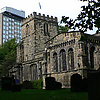

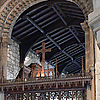
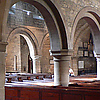
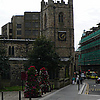
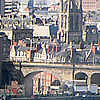

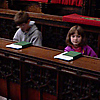

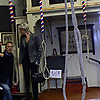

Tynemouth
The remains of a mediaeval priory and castle are right on the coast, and just above the beach. Here as in several other sites we've been in, re-enactors are on hand to made the history of the place more accessible--One of these two 'fishwives' has just lost a husband in a storm.
We went on a Sunday, but, noooo, those are not churchgoers passing in and out of that final church (next to last picture) after all--a closer look reveals that it's now a shopping mall.
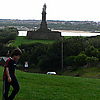
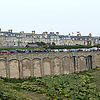


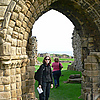

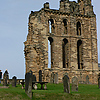

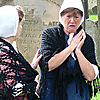
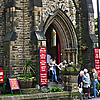
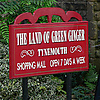
Tue, 20 Sep 2005
Warkworth castle and town
A half mile walk, up the Coquet river, you can cross in a small ferry to a small hermitage, carved out of the sandstone banks. The hermit was employed to pray for the souls of the Percy family. The sandstone was carved on the inside to appear as if it had a vaulted ceiling.
Warkworth itself is a small village a few miles from the sea with charming stone buildings, and a Norman church of St. Lawrence--patron saint of, among others, comedians and librarians.
Elena was very pleased that we *finally* rode on a double-decker bus.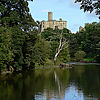

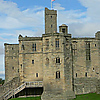
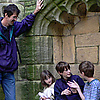
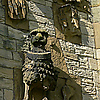
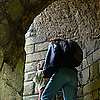
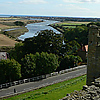
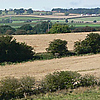
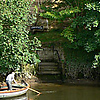
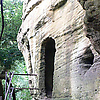

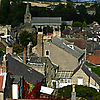
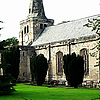
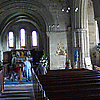
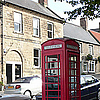
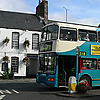
Thu, 22 Sep 2005
Peter's first day of school
In the pictures, Peter is modeling the three parts of his school 'kit'. A class uniform , and two different sports outfits. We think the one is for cricket and tennis, and the other for rugby and soccer.
Yes indeedy, Peter's very first lesson on this, his very first day in the UK schools was none other than... how to do a side-tackle in rugby!
PMS has five 'forms' (classes) of 30 students each in Years 5 to 8 (ages 9 to 13)--so about 600 children in the whole school. It shares a campus with Ponteland High School right next door.
Ponteland (and some parts of Newcastle) has a 3-tier system of primary, middle, and high-school. It seems like the recent trend is for these systems to move to a two-tier systems of primary and secondary school, where children enter the secondary school in Year 7. England does have a national curriculum and a national testing system, but there is quite a bit of local freedom in school organization:
The publicly-funded schools all seem to have their own independent boards of governors. Catholic, Church of England, and recently some Muslim schools may also receive public funds, and if so, their students pay no fees. Schools appear to have some freedom in setting their own admission criteria, though sometimes this is also coordinated with other schools through the Local Education Authority (LEA).
Families usually have the best chance to get their children into a close-by school, and there are "feeder school" relationships between some primary and higher schools. But there are no formal barriers to simply approaching any school of interest and applying for admission--subject to spots being availablee. 

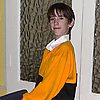

Cricket Jabberwocky England just won "The Ashes"--a cricket series against Australia. This was a huge deal since the Aussies have been pretty unbeatable against all comers for a number of years.
I understand next to nothing about the game, but it's just so *fun* to read about it!
"Michael Vaughan then struck a blow against the Kansas Board of Education. It was 20 minutes to lunch when England's captain tried tugging a short leg-break against the spin, hit it in the air as is his regrettably casual habit and was caught at mid-wicket: no evidence of intelligent design behind that shot."
[Gideon Haigh writing in The Guardian]
Tue, 27 Sep 2005
The venerable Bede
Nearby there's a small museum with a collection of Celtic Christian artwork. The portion shown of a cross outside is a modern work that takes motifs from a variety of original crosses around Northumbria (note the loaves and fishes at the top) and adds some modern elements, like the ship welder at the bottom :->
Celtic Christianity was brought to England by followers of Saint Patrick of Ireland. Later, Augustine brought Roman Christianity in 597.
During the seventh century both Celtic and Roman Christianity were being practiced. Proponents of both were brought together at Whitby in Yorkshire in 664 and the Celtic Christians accepted the leadership of the Pope.
But Celtic Christianity continued in Ireland until a lieutenant of Henry II invaded Ireland in 1171 claiming a papal mandate to Romanize the Irish Celtic church.
At "Bede's World" there's also an Anglo Saxon-era farm based on best guesses--seeing as how not much more than the post holes of wooden/thatch buildings survive this long. 
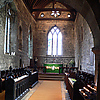
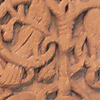
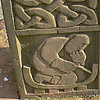
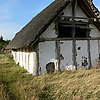
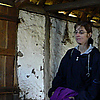
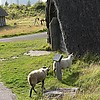
Mon, 3 Oct 2005
Teensy cars The first photo is the two-seater Smart car.
The next two are of the Nissan Micra--a car assembled in nearby Sunderland. Without luggage, we fit quite comfortably.
The next two are of a small Ford that makes the Focus look mid-sized. That gold color had not yet become fashionable in the U.S. when we left.
The next two are of a Mercedes compact.
Gas and diesel are running around US$6.50 / gallon. Quite a number of new compacts come with diesel engines.
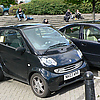
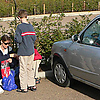
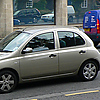
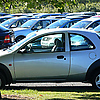

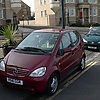

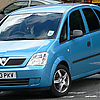
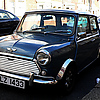
Dunstanburgh castle From Craster we took a windy walk along the coast for a bit over a mile, through fields of grazing sheep to Dunstanburgh castle, built by Thomas, Earl of Lancaster starting in 1313.
The mile we walked is part of a much longer coastal hiking/biking way which was well used while we were there.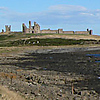
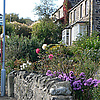
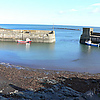
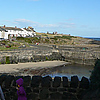
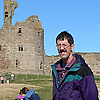
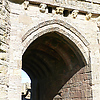
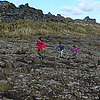


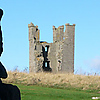
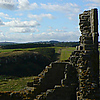
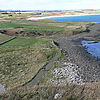
Wed, 12 Oct 2005
Running along the hedgerows
10 miles gets me from Kingston Park, over the Ouseburn ('burn' = stream), through the Savanna nature reserve, past Hazlerigg, through the Big Waters nature reserve (formed when an abandoned mineshaft collapsed) to the town of Dinnington and back.
But, aack, in the last two weeks earthmoving equipment has started pushing dirt around on both sides of the public access path (along the wooden fence in the last picture) off Kingston Park Road. I and a bunch of PWD*s still use the path--I hope it stays open. (* PWDs = people walking dogs)
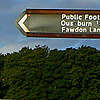
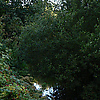
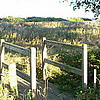
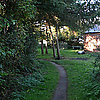
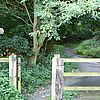

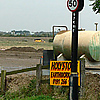
Mon, 17 Oct 2005
Fell Running-- FRA relays in Scotland The NFR had some folks back out at the last minute from their 'B' team at the FRA relays in Alva, so there was a chance for even a neophyte like me to join in, and I found myself in a car on the way to Scotland at 6 am on Sunday.
The leg which I ran was 13km and 1100m of vertical ascent. For those who were in Colorado in 2004, the length and ascent was pretty close to our hike to Surprise Lake--9 miles, 2900ft. It included Ben Cleuch, 721m (2200 ft), the highest peak in the Ochils. It took me more than two hours--About an hour more than the winning time. I am totally impressed with the shape these folks were in. I came home with bracken in my shorts, but it was a great day and great views from above.
I did not take my camera along on the course, of course, but here are some photos near the top on the Scottish Runners Association website, and here are some photos of teammates.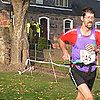
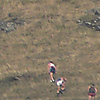
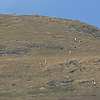
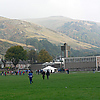

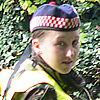
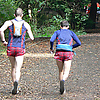

Mon, 31 Oct 2005
A brief history of hedgerows
In medieval times raising grains on the "common" land which a local landowner would make available to a rural village required many hands.
But by the 16th century many landowners found they could make a better profit with fewer people by raising sheep. The landowners put a lot of folks out of work when they enclosed some of the common lands with stock-proof hedges of Hawthorn and other species. ('Haw' comes from an Anglo-Saxon word 'hega' meaning living or border boundary.) Riots broke out, But parliamentary 'Acts of Enclosure' backed the landowners.
Nowadays there is pressure to remove hedgerows so that farmers can keep plowing without having to turn their tractors every furlong.
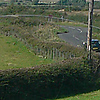
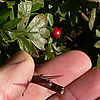
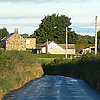
Durham
Entering the Cathedral of Durham one is at first awestruck by all that stone that they've managed to suspend up there. And then in the center of the nave you see yet further upwards into the main tower. This view even elicited amazement from those under 12.
Many of the most ancient churches in England don't necessarily look old, since they have been enthusiastically added to over the ages. The Durham Cathedral is somewhat unique in having been started and pretty much finished in Norman (Romanesque) times. It is also the final resting place of
Saint Cuthbert, and the venerable Bede.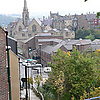
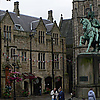
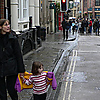
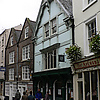
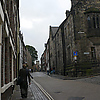
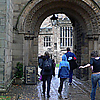

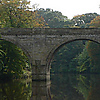
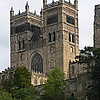
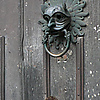

Tue, 1 Nov 2005
London Mennonite Centre
Benj and Elena would have been happy to play croquet and other things in the LMC garden rather than going off to see anything else of London. (Tim took some of these pictures).
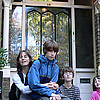
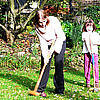
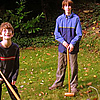
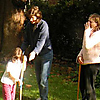
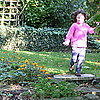
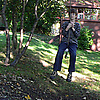
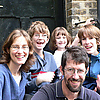
London -- Tower of London
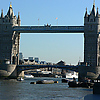
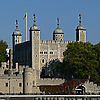
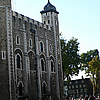
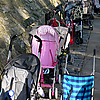




Thu, 3 Nov 2005
London -- Westminster
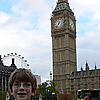
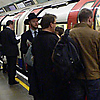
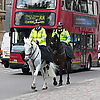
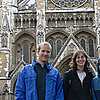
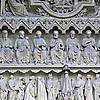
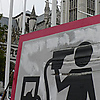

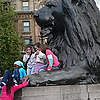

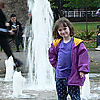
Fountains Abbey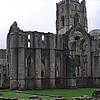
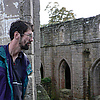
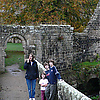
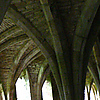

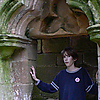

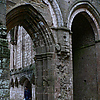

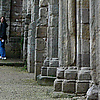
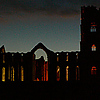
Newcastle: politest English city
Newcastle's politeness score was almost twice that of bottom-of-the-pile Birmingham. London came out somewhere in the middle.
[news.bbc.co.uk...] --
According to Reader's Digest's undercover "politeness inspectors", Newcastle is the most polite English city when it comes to shopkeepers saying 'please' and 'thank you', people holding doors and helping passers-by with dropped items, and drivers letting others cut in front of them in traffic.
Fri, 25 Nov 2005
'Unfair' competition for WalMart Tesco is the UK's largest food retailer with more than 30% of the British market. The WalMart-owned ASDA chain is in second place with less than 16% market share. There's a huge Tesco--we're talking store managers on roller skates-- just down the road from us in Kingston Park.
They are unionized and some consumer groups love their low prices. But their dominant position coupled with their recent moves to buy up convenience stores and smaller neighborhood stores is raising general fears about monolithic food provision.
Real estate seems to be a central part of Tesco's strategy--It's amassed vast land holdings and often participates in new housing developments at the planning stage. The Kingston Park store is situated right beside a metro stop, and right next to the A1 motorway. As the picture shows, there are also green bike lanes right up to the front door. But, unlike WalMart, they do *not* look kindly on anyone parking in their lot for more than two hours.

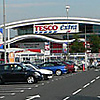
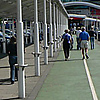
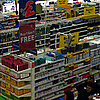


Walking around Rothbury
Paul is pictured standing in "Physic Lane". The brown, fuzzy landscape is a heather-covered moor (near the top) in late November.
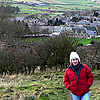
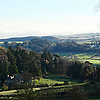
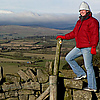
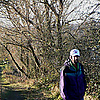

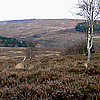
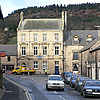
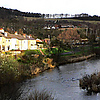
Fri, 16 Dec 2005
Christmas programs and such Elena was a dancer in a story about a mixed up camel trying to
lead the wise men to baby Jesus. (The deliciously evil King Herod is shown).
Benj was a monkey in a different production which was
was about....oh never mind. Suffice it to say that it starred a
pirate named 'Captain Christmas', female prisoners performing a dance
paean to girl power, and Tony Blair apologizing for not getting a
tree decorated...
The teachers, staff, and kids really put themselves out. They
clearly wanted every child to be involved in meaningful ways, and
every child (we estimated ca. 500 schoolwide) had a costume. Parents
paid a token amount for tickets, and partook of tea and mince pies
afterwards.
Kathy and Elena went to a Christingle service where they made these 'Christingles'.
Benj designed our tree-topping angel himself out of, among other things, a yogurt container.
Meanwhile--and not particularly connected with Christmas--Peter has been cooking
at school, and is shown here
with his latest: fruit pizza.
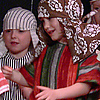


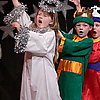
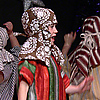
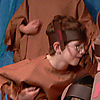

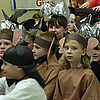
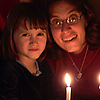


Thu, 22 Dec 2005
High noon, December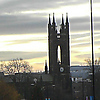
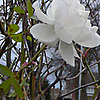
Mon, 2 Jan 2006
Christmas in the UK Some UK Christmas traditions we took part in...,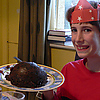

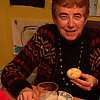
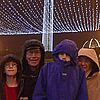
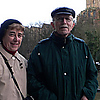
Edinburgh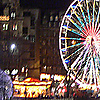
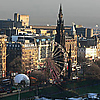
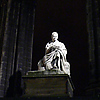
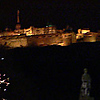

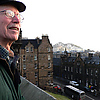
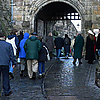
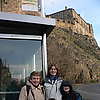
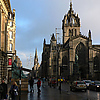
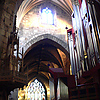
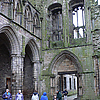
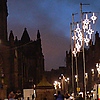
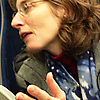
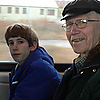
Scottishness
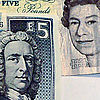
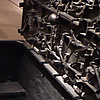
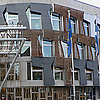
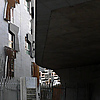
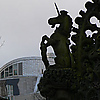
Tue, 24 Jan 2006
Belsay--hall, gardens, and castle
But what's really striking are the gardens, part of which are set in a sunken rock quarry. 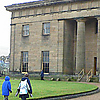

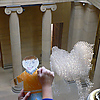
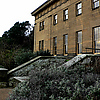
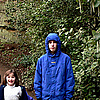
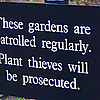
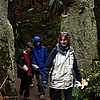
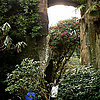
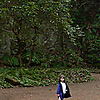
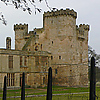
Housesteads Roman fort along Hadrian's Wall
Under-the-floor heating was employed in the Commander's house, where hot water circulated among the pillars underneath the floor slab (photo #2). One can also see a bit of the lavatory arrangements (reconstructed in more detail at Segedenum) which sported running water.
You can walk an 80 mile path from coast to coast that runs along the course of Hadrian's Wall.
Here near Housesteads, there is a good deal of the wall left, it runs over dramatic countryside, and there is a short section where you can actually get on top of the wall itself (photo of three kids).
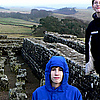
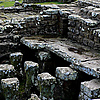
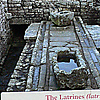
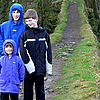


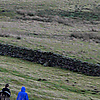
Mon, 6 Feb 2006
Museum of antiquities U. Ncl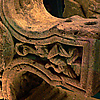
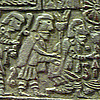
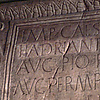
Grey's Monument We had been on a list to get into the monument since September. Only seven people at a time are allowed up at a time on occasional Saturdays, and our turn finally came this weekend. The kids counted 164 steps to the top. Great views of the downtown, though a bit hazy further off. You can still see the landmarks of the 'New'castle and the lantern spire of Saint Nicholas in the middle distance.
Earl Grey was a Whig most famous for his career-long passion for Parliamentary reform, culminating in the reform act of 1832.
He also oversaw the act that abolished slavery from the British Empire in 1833.
Members of Parliement at that time included the patrons of historically privileged villages with a handful of houses. Meanwhile the new industrial cities, such as Manchester, had no representation. But how can you change a system in which a few wield power to one of more proportional representation?
Reform was a very popular cause, but failed repeatedly in the House of Lords. Grey succeeded by convincing the King to appoint a flock of new, sympathetic Whig as peers, thus 'packing' the House of Lords!
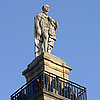
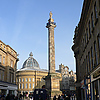

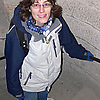
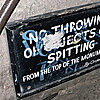
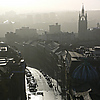
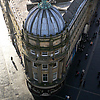
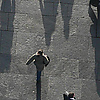

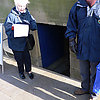
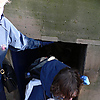
Thu, 23 Feb 2006
Holy Island--Lindisfarne castle
The Lindisfarne Castle on Holy Island is a Tudor structure built in the 16th century to defend the coast, and was refurbished inside in 1902 as a comfortable vacation home.
The castle is normally closed in the winter, but was open this week because it's half-term holiday in the Northumberland schools.
One can just catch a glimpse of Bamburgh Castle a few miles further south along the coast.
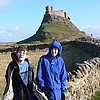
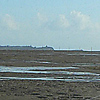

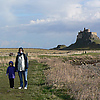
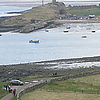

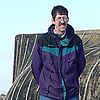
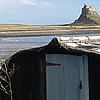
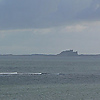
Holy Island--Lindisfarne Priory
Scholarship flourished in the century or two after Aidan, a time sometimes called the Northumbrian Renaissance, which saw the completion of the Lindisfarne Gospels, and Bede's notable history in 735.
The monastery was sacked by vikings in the 9th century. The current ruins are those of an 11th century Benedictine abbey built on the site of Aidan's monastery.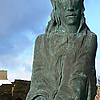
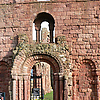
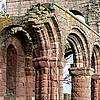
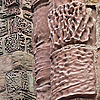
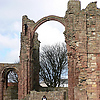
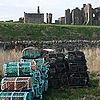

Berwick upon Tweed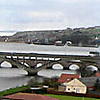
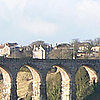
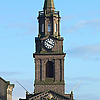
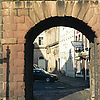
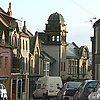
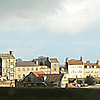
The purple flash rides again
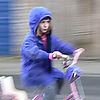
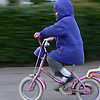
Thu, 30 Mar 2006
Saltwell park It lies across the Tyne river in Gateshead, which hosts a significant Jewish community. The last snapshot is of the Talmudical college.
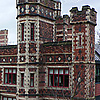
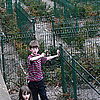

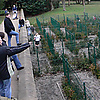
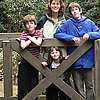
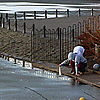
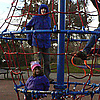
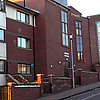
Katie comes for a visit We had more snow the week she was here than the rest of the winter combined, but Katie quite gamely walked all over Newcastle, down by the quayside, the Roman settlement at Vindolanda and the coast near Tynemouth. 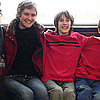
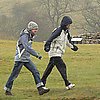
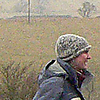
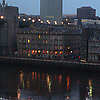

Sat, 22 Apr 2006
Jeannie and Jacob
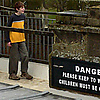


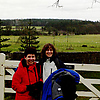

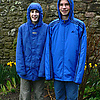
Amsterdam for cyclists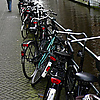
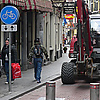

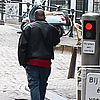
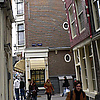
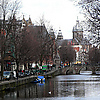
Back to Bochum
Despite strikes by some of the University workers, the conference came off smoothly. I stayed with Katharina (pictured) and her family. She organized the conference.
On the way to Bochum I visited other friends with Goshen connections. Sabine (pictured with their two offspring) and Herbert live in Wolfsburg--the VW company town erected in the late 1930's. They live close to 'Burg Neuhaus' (something like 'New Castle'!), a 14th century castle which now serves many community functions, including hosting a kindergarten which Sabine and Herbert's kids attended.
David and Margarita live in Bielefeld right next to her brother and minutes away from the rest of her family. David put most of the labor into building their house (pictured) which they recently moved into.
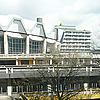
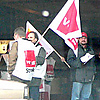
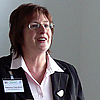
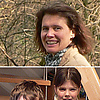
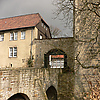
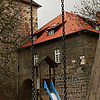
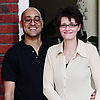
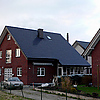
Lambs and prehistoric settlements
We visited her erstwhile cottage in the midst of a large sheep operation. We chatted with the farmer who said his flock was giving birth to about 800 lambs over the course of three-four weeks. All the ewes are scanned (ultrasound?) ahead of time and grouped in pens according to whether they're expecting one, two, or three. The lambs are kept in the barn for 24 hours then sent out to the fields with their mothers and with (new this year) little plastic coats to keep them warm that rip off after a few days and biodegrade.
There are the remains of an Iron-age hillfort above Karen's house. One can still make out the remains of an enclosing wall, and hollows in the top of the hill where individual houses probably stood. Nearby there are some pre-historic "cup and ring" carvings in the stones.
Spring is fitfully arriving. The last-but-one photo shows Benj examining some blossoming gorse bushes.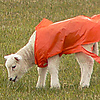

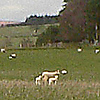
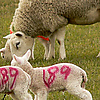
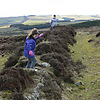
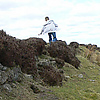
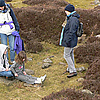
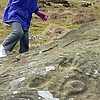
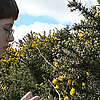
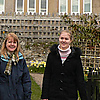
Fri, 28 Apr 2006
The pyramids of Giza
Of course, we had to see the pyramids at Giza, on the edge of Cairo--the complex which also includes the Sphinx. The Great Pyramid was the tallest building in the world up until the 19th century.
Kathy is peering into a pit in which a complete boat was discovered--part of the retinue of Cheops. Pieced back together, it is now housed beside the Great Pyramid.
Supper--within sight of the pyramids--included baba ghanoush, falafel, hummus, and other things made of ground fava beans and eggplants.
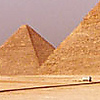
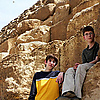
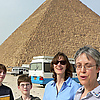


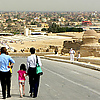

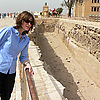
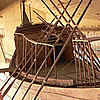

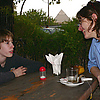
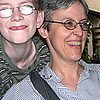
Mosques of Cairo
Our children may remember running around and playing tag in the courtyards more than anything else!
The last mosque (of Ibn Tulun) had a climbable minaret tower from which one could view satellite dishes sprouting like mushrooms to the horizon.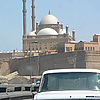
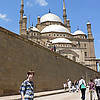
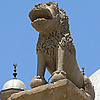

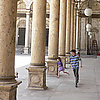
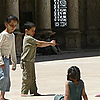
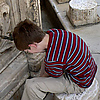
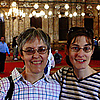
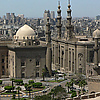
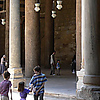
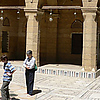
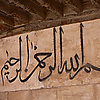

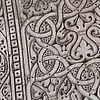
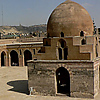
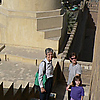
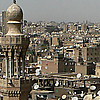
Sat, 29 Apr 2006
Cairo street snapshots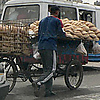
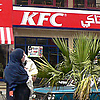
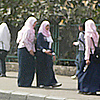
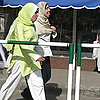

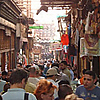
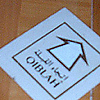
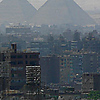
Beside the Nile
We didn't see a lot of parks around Cairo, but the sidewalks along the Nile seemed a popular place to stroll.
We stayed in Lise' AUC apartment in Garden City, within a stone's throw of the Nile. The guidebooks say that Garden City was originally built as a suburb by British colonial administrators with curved, tree-lined streets to evoke the English countryside. Though high-rises have taken over, the trees have remained.
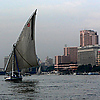
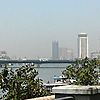

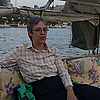
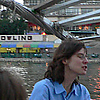
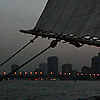
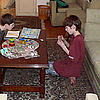
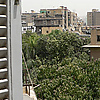

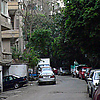
Tue, 9 May 2006
May Day hike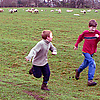
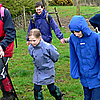

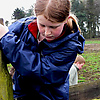
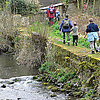
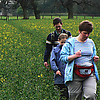
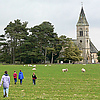
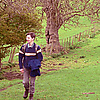
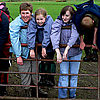
York The National Rail Museum has a fine collection, including the Mallard--the fastest (126 mph) ever steam engine (pictured), and many coaches from royal trains since Queen Victoria.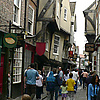
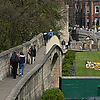
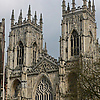
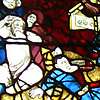
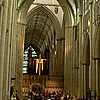
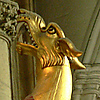
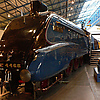
Hiking Hadrian's Wall The wall was built in AD 122-130 to keep those Scottish tribes at bay. Milecastles were built every (Roman) mile, as well as two manned turrets between adjoining milecastles. In addition to the wall itself which originally ran nearly ~73 miles from coast to coast, other Roman remains along this section include:
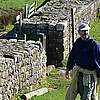
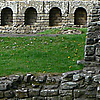
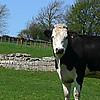
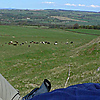
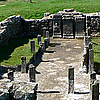
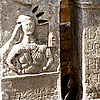
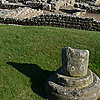
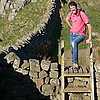
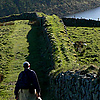
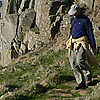
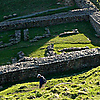
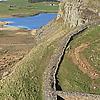
Tue, 23 May 2006
Belsay
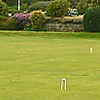
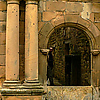
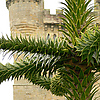
Wallington This manor house about a half an hour from Newcastle has some amusing pictures (not photographable) painted inside illustrating scenes of Northumberland history. Red squirrels roam the forest.
What *are* those sheep up to behind Peter?
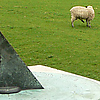
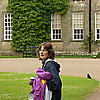


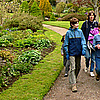
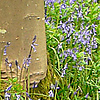

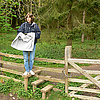
Fairfield Horseshoe fell run The top was in the clouds. But there were plenty of hikers about to guide, errm, some of us back to the pack as needed.
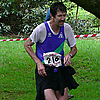
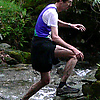
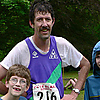
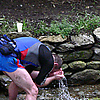

Football Fever In the last month, England flags have sprouted on automobiles in anticipation of this summer's World Cup.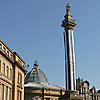
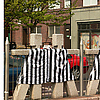
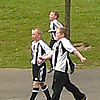
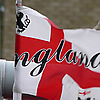
Thu, 1 Jun 2006
Bamburgh
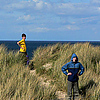
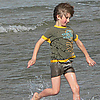
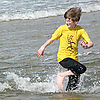
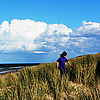
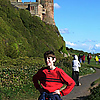
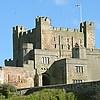
The Farne Islands: Puffins, St. Cuthbert, seals, Grace Darling, and other wildlife
These small islands, each no more than a few acres, are the nesting grounds for puffins, guillemots, terns, shags, cormorants, eider ducks and more. There is also a colony of gray seals.
St. Cuthbert, now buried at Durham Cathedral, lived on the Inner Farne island at various times in his life. Beside the small chapel in his memory, the terns are pecking at tourists passing through their nesting grounds.
The islands were also the home of Grace Darling, heroine of Northumberland. The daughter of a lighthouse keeper, she spied survivors from a shipwreck and with her father rowed to their rescue in 1838. They lived on the site of the current (red and white) lighthouse. The last but one picture shows an earlier, pre-electric lighthouse, with a squat rectangular tower, on top of which the lighthouse keeper kept a fire burning when needed.
Thomas shows off the jumbo-size of fish and chips in Seahouses.
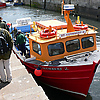
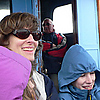
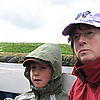

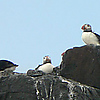

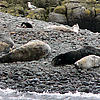
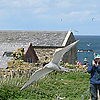
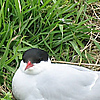
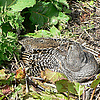

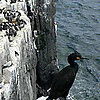
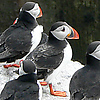
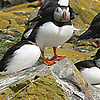
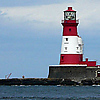
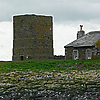
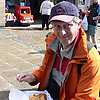
Fri, 14 Jul 2006
Friends and relatives on the Wall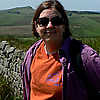
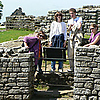
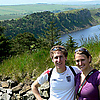
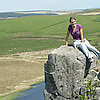
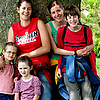
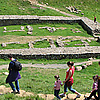
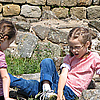
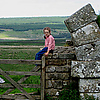
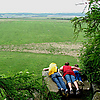
Sat, 15 Jul 2006
Cragside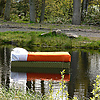
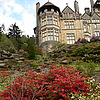
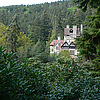
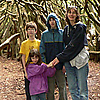
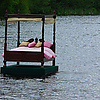
Sun, 16 Jul 2006
Meyer Trip (MT) -- Paris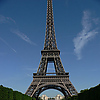
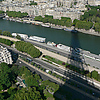

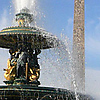
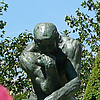
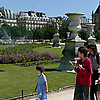
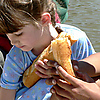
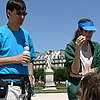
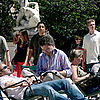
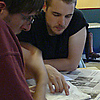
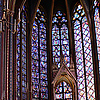
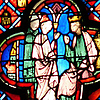
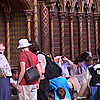
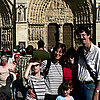
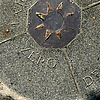
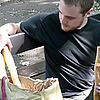
Mon, 17 Jul 2006
MT Petite Clamart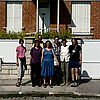


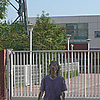
Tue, 18 Jul 2006
MT Versailles
This recent Guardian article claims that Versailles' best-known queen, Marie Antoinette, is now more popular than ever in France.
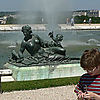

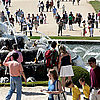

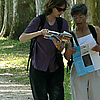
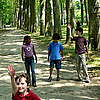
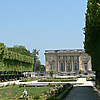
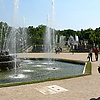
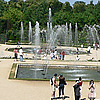
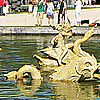
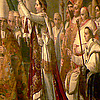
MT Sunday in Paris
Other photos of Montmartre and the Musée d'Orsay .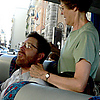
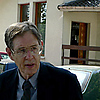
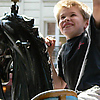

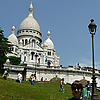
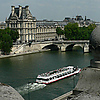
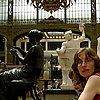
Thu, 20 Jul 2006
MT from Paris to Alsace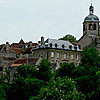
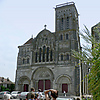
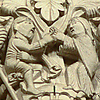

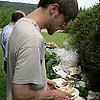
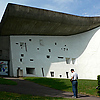
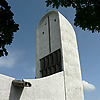
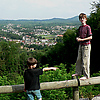
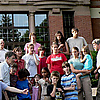
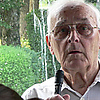
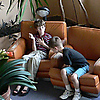
Tue, 25 Jul 2006
MT Alsace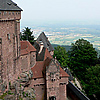
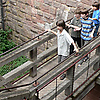
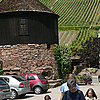
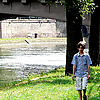
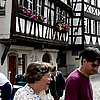
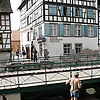
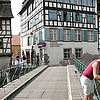
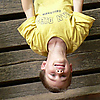
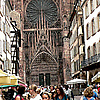
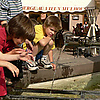
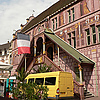
Sun, 6 Aug 2006
MT around Switzerland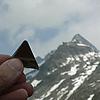
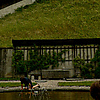
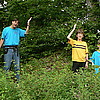
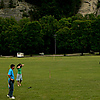
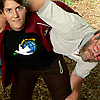
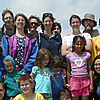
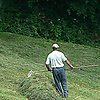

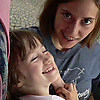

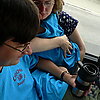

MT Zermatt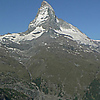
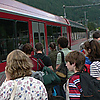
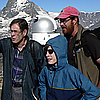
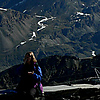
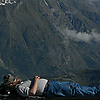

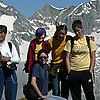
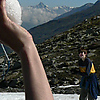
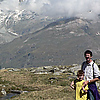
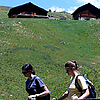
Mon, 7 Aug 2006
MT St. Joder Chapel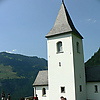
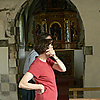


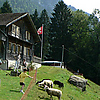
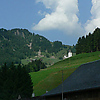
Mon, 14 Aug 2006
MT Basel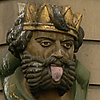

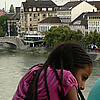
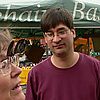
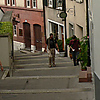
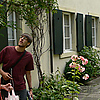
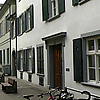
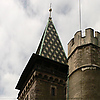
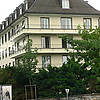
MT Zurich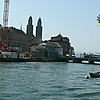
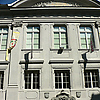
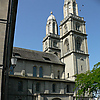
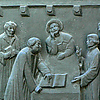
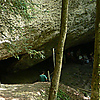
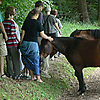
Paul reads again
I Can't get a definitive glasses prescription until the stitches dissolve, and swelling goes down. But meanwhile I'm reading again by stacking a couple of lenses together 8->

Sun, 3 Sep 2006
Back to the U.S.A.
On July 2 we took our eight suitcases and six carry-ons across five time zones back to Goshen. First impressions on arriving back in the midwestern U.S.: That haze and humidity, and the funny, fat milk containers we have here.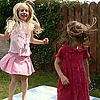
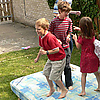
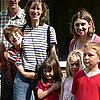
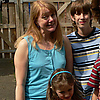
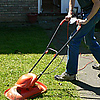
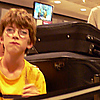
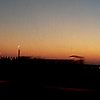
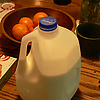
Saqqara Saqqara is in the desert just above the Nile valley. Looking back, you can see the contrast with the irrigated land.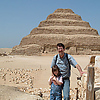
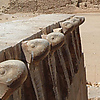
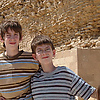
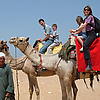
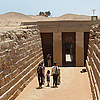
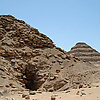
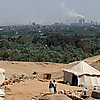
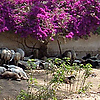
Wed, 24 Jan 2007
